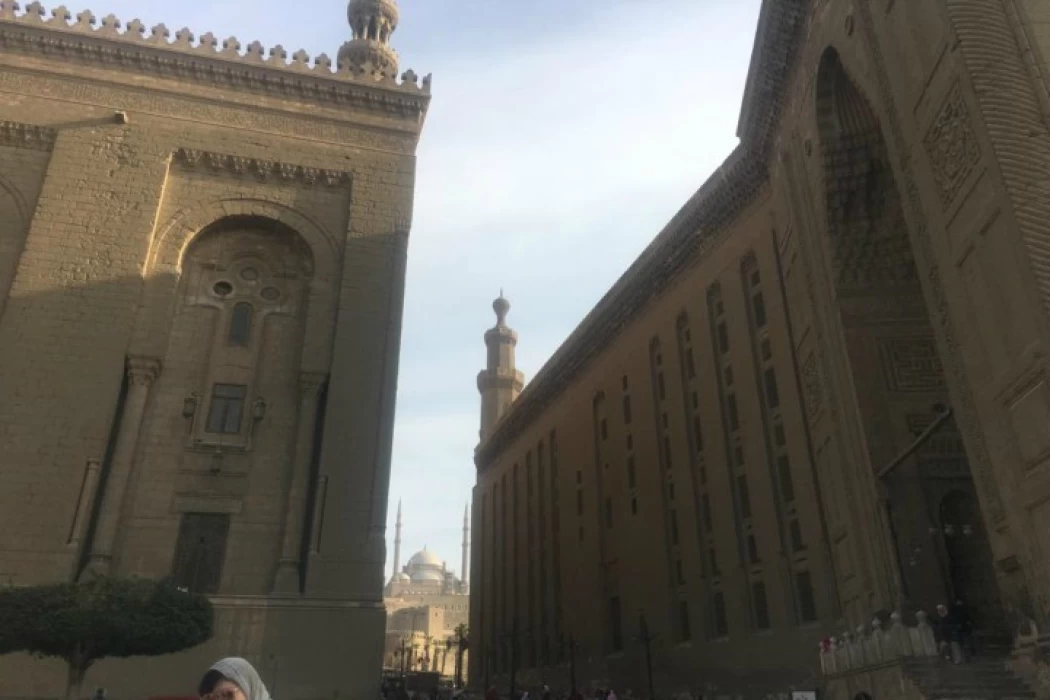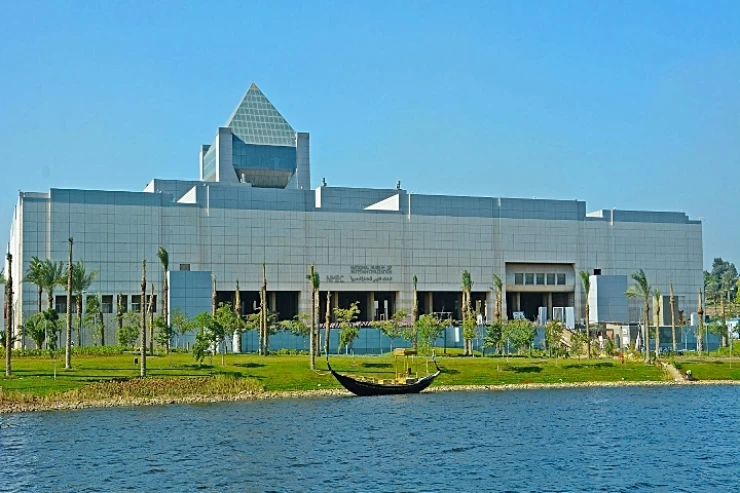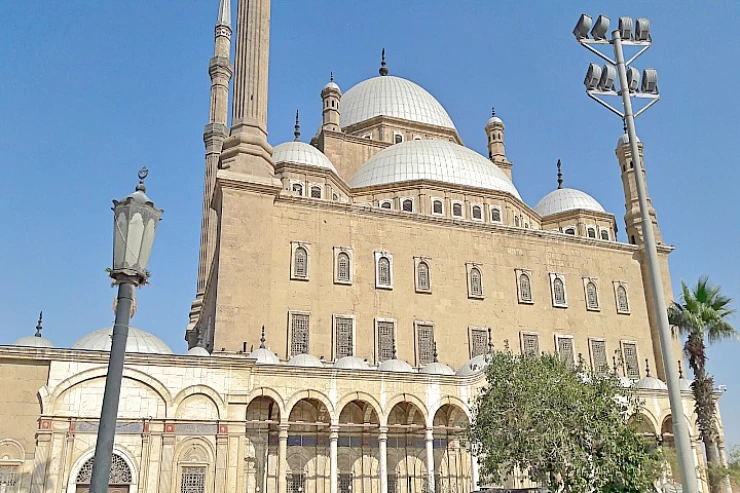
Sultan Hassan Complex
Sultan Hassan Complex
The Sultan Hasan Mosque-Madrasa is a large mosque and religious school situated in Salah al-Din Square in Cairo's historical area. Constructed between 1356 and 1363 in the era of Bahri Mamluk rule, it was ordered by Sultan an-Nasir Hasan. The mosque was notable for its large size and creative architectural features, remaining one of Cairo's most impressive historic monuments today.
Interior of Sultan Hassan Complex
The Sultan Hassan Complex stands out for its large size and ornate decoration, making it a true gem of ancient Islamic Art in Islamic Cairo structures. "Gomar" mentions the Mosque-Madrasa of Sultan Hasan in a book about Egypt. This fact makes it a significant stop on Egypt tours because it showcases the rich Islamic history of the Sultan Hassan Mosque & Madrasa (Masjid al-Sultan Hasan Cairo).
Al Rifai Mosque, also known as The Royal Mosque, is a popular attraction located close to Sultan Hassan Complex.
Old Cairo with Islamic influences.
Due to its tall dome, the minaret's height, width, luxuriousness, and decorations, it is one of Cairo's most exquisite structures. Al-Maqrizi characterized it as one of the Muslim shrines not recognized in Islam that resembles a mosque but still merits inclusion in your Cairo day trips. The tallest entrance in Islamic Cairo, along with being the largest building in the area, made it stand out as one of the most distinctive attractions in Cairo. The complex includes a Musque, school facilities, and accommodations for students and teachers to stay overnight. There are four schools that provide education on the four Sunni rites. The Mosque of Sultan Hassan is a beautiful attraction to explore during your Egypt day tours, making it a must-see destination in Cairo and Islamic Cairo, as well as potentially one of the top sights globally. The walls reach a height of 36m and the tallest minaret measures 68m in height. A dim, low-ceilinged hallway guides you to the cozy, gleaming courtyard in the form of a cross. The focal point of the courtyard was a domed ablutions fountain, likely added during the Ottoman era. Round iwans (sitting rooms) encircle the patio, adorned with hanging lamp chains and red-and-black rims.
The mosque and various other building accomplishments of the Muslim community in Cairo can be explored on Egypt Luxury tours where you can enjoy top-notch hotels and Nile cruises. Alternatively, for those on a budget, Egypt cheap budget tours offer a range of cost-effective options. If you have been injured and experience physical limitations, consider these tours as well.
The Mosque and Madrasa of Sultan Hassan is one of the most stunning examples of Islamic architecture in Cairo, and it is not surprising that the mosque is situated around the Citadel of Saladin, in the interior of Old Cairo. The complex embodies the epic proportions of Mamluk architecture and is famous for its great scale, beautiful intricate patterns and detail, and its past. Visitors around the globe make pilgrimages to the beauty and history of this architectural and cultural masterpiece, which is the pride of the Mamluk Sultanate.
Historical Overview
This mosque and khanqah compound construction was commissioned by Sultan Hassan bin al-Nasir Muhammad around the year 1356 AD, and he intended it to be more than a mosque as it would serve as a madrasa (school of study) for the four major Sunni sects of Islam: Hanafi, Maliki, Shafi’i, and Hanbali. The construction of the tomb was commenced in the 1356 Christian era, which took around seven years to complete. It was also used as a place to learn and worship. But the bad part was that, alas, within a matter of hours, after the Sultan ordered his last and grandest design, the Sultan was assassinated, thus enhancing the myth.
The complex was built in one of the cities that over the years have suffered many interruptions within its history, internally due to earthquakes as well as military sieges, some of which rendered its architectural design adversely. But it has remained a significant symbol of Mamluk rule and devotion and continues to be open for worship and visitors.
While the Sultan Hassan Complex has much to offer, its enormous scale is undoubtedly the most impressive feature. The main entry that is just under 26 meters in height leads to a courtyard that is surrounded by walls that rise to a height of 36 meters. The entire mosque covered about 7900 square meters, making it one of the biggest mosques in the globe. The building’s symmetrical stone elevation and rich use of geometrical decor and ornamental monuments are typical Mamluk architectural designs.
Also, within the mosque’s interior—except for the one iwab—which houses four schools of Sunni Islam and a large central courtyard, which is encircled by four iwans. The Iwan located at the center pointing to Mecca is enhanced with elaborate stucco work and marbles, as well as a decorated'mihrab.'.’ The courtyard is also properly arranged with the help of vertical members in the form of columns. The guests will also admire the lofty walls of the space, which have curved ceilings, creating an almost ethereal feeling in the room.
The organization, which is popularly referred to as the madrasa or Islamic institution in its primary sense, was one of the objects of the original vision of the complex. So all four iwans also served as classrooms for one of the Sunni judicial schools. This period also explains the presence of such illustrious personages in the inner chambers surrounded by students hailing from every corner of the Muslim world due to its esteem as the pinnacle of education.
The institution committed to the good health of its students as well. This implied that in addition to regular classes being offered, nutrition, dormitories, and a reading room were also provided to the students. The madrasah is covered by Koranic verses placed on the walls as ornaments and motivational resources for the student scholars who were within its confines.
Equally intriguing is the tomb of Sultan Hassan, which is another distinguishing element of the Sultan Hassan Complex. The tomb is in the back of the main prayer room and is said to be one of the best preserved examples of Mumluk burial architecture. The dome is surmounted by a giant dome that is 21 meters in height and is embellished with beautiful arabesques and inscriptions. Based within the mausoleum, there lies the sarcophagus of Sultan Hassan, encased in walls of marble embedded with Mamluk-style masterpieces.
Interestingly, Sultan Hassan’s body was never interred in this mausoleum, as he was killed before the complex was completed, and his remains were buried elsewhere. Nevertheless, the mausoleum remains a symbolic resting place and is a beautiful tribute to his memory.
The Sultan Hassan Complex is a superlative work of Islamic art and architecture, with every detail thoughtfully designed and executed to fit the Mamluk style. The walls and ceilings are clad in arabesques, geometric designs, calligraphy, and other typical components of Islamic art. The fishtail and stucco carving works, embellished on the surfaces, unequivocally demonstrate the exceptional artistry that went into building the entire complex.
Among the dominant artistic aspects, one cannot miss the beautiful wooden mashrabiya, which has elaborate floral and geometric carvings in it, encouraging the eye to explore its design. In addition to enhancing the beauty of the complex, these screens also provide ventilation as well as privacy. Another thing that adds beauty to the mosque is its mihrab, which is made of marble and embellished with decorative panels and mosaics that instill a certain level of spirituality.

















